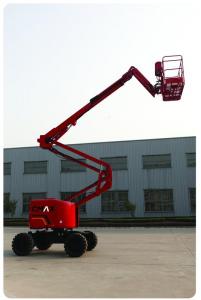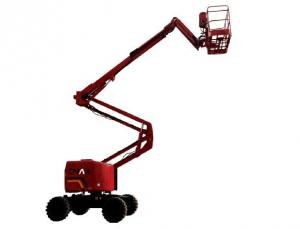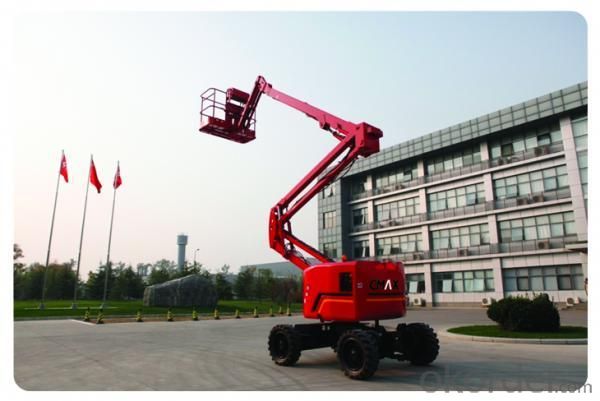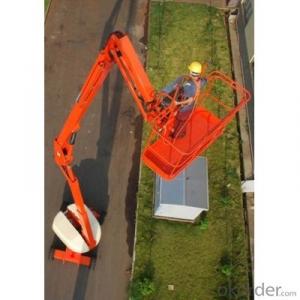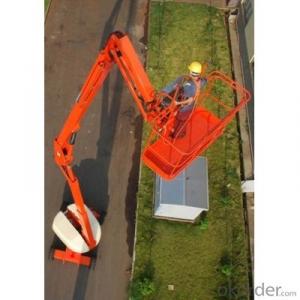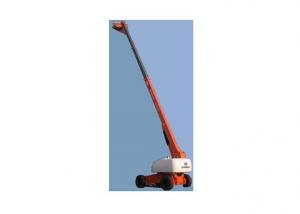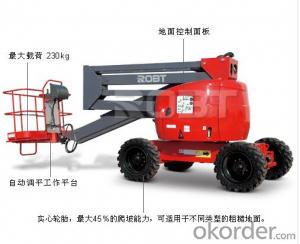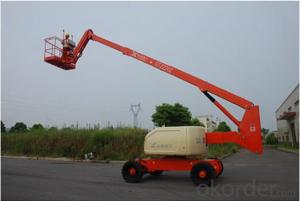Articulated Boom Lift
- Loading Port:
- China Main Port
- Payment Terms:
- TT or L/C
- Min Order Qty:
- 4 Sets m.t.
- Supply Capability:
- 30 Sets Per Month m.t./month
OKorder Service Pledge
OKorder Financial Service
You Might Also Like
GTQZ series self-propelled boom lift
can drive flexibly and freely, with side working scope and high efficiency. Hydraulic motor realize 40% grade-ability through planetary
reduction box. Telescopic boom and cylinders are protected with dust proof jacket to prevent dust in.
GTQZ Aerial work plaftform application
generally used for temporary, flexible access purposes such as maintenance and construction work or by firefighters
for emergency access, which distinguishes them from permanent access equipment such as elevators. They are designed to lift limited
weights — usually less than a ton, although some have a higher safe working load — distinguishing them from most types of cranes
. They are usually capable of being set up and operated by a single person.
GTQZ BOOM LIFT SPECIFICATION
Max. working height(m): 17.3
Max. platform height(m): 15.5
Travelling when lifts(kg): 8100(12 boom)
Max. lifting torque(kN m): 2062
Boom length: 12~30(standard configuration 18m)
Working range: 4~29(outriggers extended)
Elevation range: 22~77
Max. lifting height(mm): 27650 (with 30 boom)
Axle base(mm): 2650+1300
Wheel base fromt/rear(mm): 2400/2400
Ground clearance(mm):225
Gradeability(%):21
Min. turning diameter(m): 20
GVW(with 12m boom)(kg): 49700
Outigger type: H type
Machine dimension(without boom)(L×W×H)(mm): 7460× 3315× 3710
Machine dimension(with 12m boom)(L×W×H)(mm): 17150× 3315× 3710
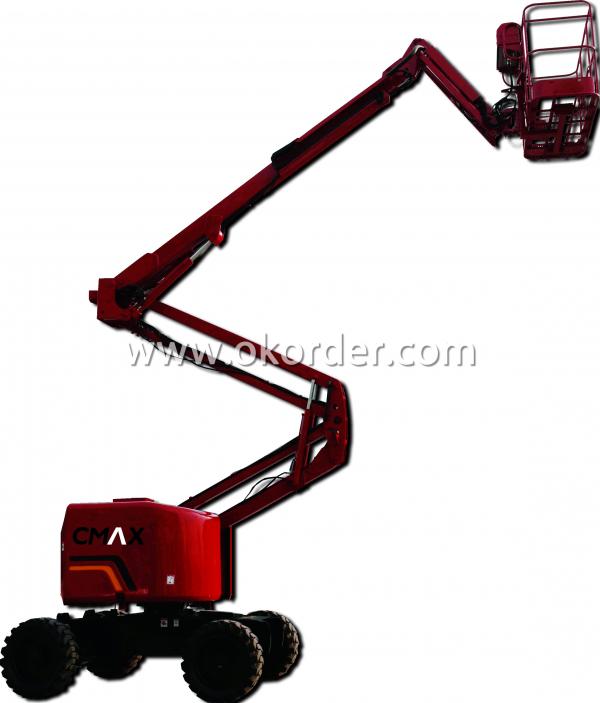
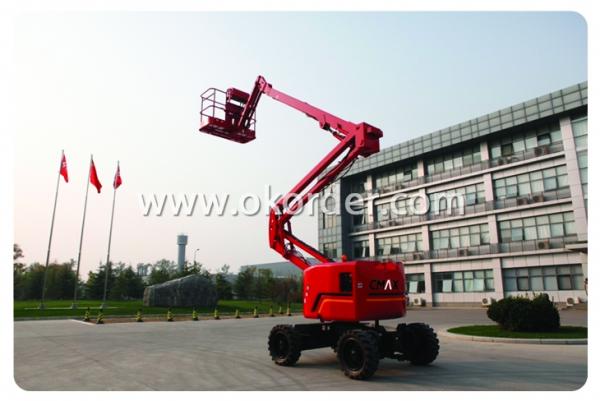
- Q: This question asks about the methods to ensure that lifting equipment is correctly positioned and functioning during its operation.
- <p>To ensure that lifting equipment is properly aligned during operation, follow these steps: 1. Conduct a thorough inspection before use, checking for any visible damage or misalignment. 2. Use precision measuring tools to verify the alignment of the equipment's components. 3. Adhere to the manufacturer's guidelines and specifications for alignment. 4. Regularly calibrate the equipment to maintain accuracy. 5. Train operators on proper alignment procedures and safety protocols. 6. Implement a maintenance schedule to address any alignment issues promptly. 7. Use load testing to confirm that the equipment can handle the intended load without misalignment. Proper alignment is crucial for safety and efficiency in lifting operations.</p>
- Q: The staff on the construction platform shall not exceed the number of people
- Depending on the actual situation, different quality of platform specifications will affect the number of people manned. Hope can help you.
- Q: This question asks for steps to ensure that lifting equipment is safe and reliable before it is used.
- <p>To ensure your lifting equipment is safe and reliable before use, follow these steps: Inspect the equipment for any visible damage or wear. Check all safety features such as hooks, cables, and brakes. Ensure that the equipment is properly maintained and serviced according to the manufacturer's guidelines. Verify that all safety certifications and inspection records are up to date. Conduct a thorough pre-use check, including testing the equipment's lifting capacity and stability. Ensure that all operators are trained and certified to use the equipment. Never use equipment that has not been inspected or is showing signs of damage. Always follow the manufacturer's guidelines and safety protocols.</p>
- Q: Is it permissible to use a building hoist for lifting a person?
- <p>No, a building hoist should not be used for lifting a person. Building hoists are designed for lifting materials and equipment, not people. Using a building hoist to lift a person is extremely dangerous and can result in severe injury or death. It violates safety regulations and is not recommended under any circumstances. Always use appropriate personnel lifting equipment or platforms designed specifically for carrying people.</p>
- Q: What are the benefits and drawbacks of utilizing a building hoist in construction?
- <p>Advantages of using a building hoist include increased efficiency in material transportation, reduced manual labor, and improved safety by minimizing the risk of accidents associated with manual handling. They can also speed up construction timelines by allowing for continuous material flow. Disadvantages include the initial cost of the hoist, the need for regular maintenance, and potential downtime in case of mechanical failure. Additionally, building hoists may have limited capacity and may not be suitable for all types of construction projects, especially those with irregular shapes or limited space for installation.</p>
- Q: What is the capacity range of a building hoist in terms of lifting objects?
- <p>A building hoist can be used for lifting both large and small objects, depending on its design and capacity. These hoists are engineered to handle various weights, typically ranging from a few hundred pounds to several tons. The specific size and weight of the objects that can be lifted are determined by the hoist's lifting capacity, which is a crucial factor to consider when selecting a hoist for a particular job. It's important to ensure that the hoist's capacity exceeds the weight of the objects to be lifted for safety and efficiency.</p>
- Q: Is it possible to utilize a building hoist for construction or renovation purposes?
- <p>Yes, a building hoist is commonly used for construction and renovation work. It is designed to lift materials and workers vertically, making it an essential tool for multi-story construction projects. Hoists facilitate the movement of heavy materials like cement, bricks, and steel, as well as personnel, enhancing efficiency and safety on the construction site. They are particularly useful in scenarios where cranes are impractical or unavailable, making them a vital component in the construction and renovation process.</p>
- Q: This question asks for the distinctions between two types of building hoists: manual and automatic.
- <p>Manual building hoists require human effort to operate, typically involving a pulley system and manual controls. They are generally less expensive but slower and more labor-intensive. Automatic building hoists, on the other hand, are motorized and can be programmed to lift and lower loads with minimal human intervention. They offer greater efficiency, speed, and safety, but come at a higher cost. Automatic hoists are also more suitable for high-rise construction due to their ability to handle heavier loads and operate over greater distances.</p>
- Q: Is it possible for a building hoist to experience malfunctions that lead to damage?
- <p>Yes, a building hoist can malfunction and cause damage. Malfunctions can occur due to various reasons such as mechanical failure, operator error, or poor maintenance. These malfunctions can lead to accidents, including dropped loads, structural damage, or even injuries to workers. Regular inspections, proper maintenance, and adherence to safety protocols are crucial to minimize the risk of hoist malfunctions in construction settings.</p>
- Q: Is it possible to use a building hoist for lifting lightweight items?
- <p>Yes, a building hoist can be used for lifting light objects, provided it is within the hoist's weight capacity. Building hoists are versatile and can handle various loads, but it's crucial to ensure the object's weight does not exceed the hoist's specified limit to maintain safety and prevent damage to the equipment. Always refer to the manufacturer's guidelines for the maximum load capacity and adhere to safety protocols when operating a building hoist.</p>
Send your message to us
Articulated Boom Lift
- Loading Port:
- China Main Port
- Payment Terms:
- TT or L/C
- Min Order Qty:
- 4 Sets m.t.
- Supply Capability:
- 30 Sets Per Month m.t./month
OKorder Service Pledge
OKorder Financial Service
Similar products
Hot products
Hot Searches
Related keywords

